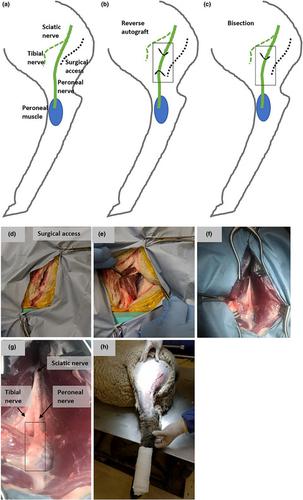当前位置:
X-MOL 学术
›
Eur. J. Nerosci.
›
论文详情
Our official English website, www.x-mol.net, welcomes your feedback! (Note: you will need to create a separate account there.)
Long-term neural regeneration following injury to the peroneal branch of the sciatic nerve in sheep.
European Journal of Neroscience ( IF 3.4 ) Pub Date : 2020-05-25 , DOI: 10.1111/ejn.14835 Kelly C S Roballo 1 , Daniel T Burns 1 , Adel B Ghnenis 1 , Wupu Osimanjiang 1 , Jared S Bushman 1
European Journal of Neroscience ( IF 3.4 ) Pub Date : 2020-05-25 , DOI: 10.1111/ejn.14835 Kelly C S Roballo 1 , Daniel T Burns 1 , Adel B Ghnenis 1 , Wupu Osimanjiang 1 , Jared S Bushman 1
Affiliation

|
Peripheral nerves (PNs) are frequently injured as a result of trauma or disease. Development of therapies to regenerate PNs requires the use of animal models, typically beginning in rodents and progressing to larger species. There are several large animal models of PN regeneration that each has their benefits and drawbacks. Sheep have been used in PN studies due to their similarities in body weight to humans and the ease and lesser expense in their care and housing relative to other species. We have investigated the use of sheep for studies of PN regeneration and have developed and tested an injury model in the peroneal branch of the sciatic nerve. Three experimental groups were tested on mature sheep: a bisection; a 5‐cm reverse autograft; and sham surgery. Protocols were developed for the post‐operative care for animals with this injury, and regeneration was tracked for extended time points via compound muscle action potentials (CMAPs) and endpoint assessments of nerve morphometry, muscle mass and muscle fibrosis. Results indicate the practical viability of this PN injury model and show distinctions in the degree and rate of regeneration between bisection and reverse autograft that persisted 14 months. This long‐term study shows bisections lead to significantly improved CMAPS and muscle mass and lesser muscle fibrosis as compared to reverse autograft. The persistence of these discernable changes between two relatively similar experimental groups out to extended time points is an indication of the sensitivity of this nerve section and its potential applicability for comparative studies.
中文翻译:

绵羊坐骨神经腓总支损伤后的长期神经再生。
周围神经(PNs)经常由于外伤或疾病而受伤。再生PNs的疗法的开发需要使用动物模型,通常从啮齿动物开始并发展为更大的物种。PN再生有几种大型动物模型,每种都有其优点和缺点。由于绵羊与人的体重相似,并且相对于其他物种而言,绵羊在护理和住房方面的便利性和费用较低,因此它们被用于PN研究。我们已经研究了使用绵羊进行PN再生的研究,并开发并测试了坐骨神经腓骨分支的损伤模型。在成年绵羊上测试了三个实验组:两等分;5厘米反向自体移植; 和假手术。制定了针对这种损伤的动物进行术后护理的方案,并通过复合肌肉动作电位(CMAP)以及神经形态,肌肉质量和纤维化的终点评估跟踪了延长时间点的再生。结果表明了这种PN损伤模型的实际可行性,并显示了对分和反向自体移植持续14个月的再生程度和再生率的差异。这项长期研究显示,与反向自体移植相比,平分术可显着改善CMAPS和肌肉质量,并减少肌肉纤维化。在两个相对相似的实验组之间,这些可识别的变化持续存在到延长的时间点,表明该神经节的敏感性及其在比较研究中的潜在适用性。
更新日期:2020-05-25
中文翻译:

绵羊坐骨神经腓总支损伤后的长期神经再生。
周围神经(PNs)经常由于外伤或疾病而受伤。再生PNs的疗法的开发需要使用动物模型,通常从啮齿动物开始并发展为更大的物种。PN再生有几种大型动物模型,每种都有其优点和缺点。由于绵羊与人的体重相似,并且相对于其他物种而言,绵羊在护理和住房方面的便利性和费用较低,因此它们被用于PN研究。我们已经研究了使用绵羊进行PN再生的研究,并开发并测试了坐骨神经腓骨分支的损伤模型。在成年绵羊上测试了三个实验组:两等分;5厘米反向自体移植; 和假手术。制定了针对这种损伤的动物进行术后护理的方案,并通过复合肌肉动作电位(CMAP)以及神经形态,肌肉质量和纤维化的终点评估跟踪了延长时间点的再生。结果表明了这种PN损伤模型的实际可行性,并显示了对分和反向自体移植持续14个月的再生程度和再生率的差异。这项长期研究显示,与反向自体移植相比,平分术可显着改善CMAPS和肌肉质量,并减少肌肉纤维化。在两个相对相似的实验组之间,这些可识别的变化持续存在到延长的时间点,表明该神经节的敏感性及其在比较研究中的潜在适用性。


























 京公网安备 11010802027423号
京公网安备 11010802027423号